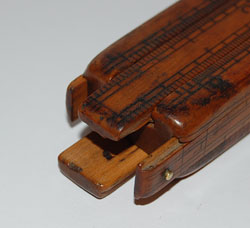 |
 Up
Up
|
|

|

|
A lovely gauging slide rule |
|
|
|
|
|
|
This beautiful slide rule is the oldest item in my collection (so far, anyway). How old, you ask? Well, remember “No taxation without representation”, and how the British government’s obsession with taxation led to Britain losing her American colonies in 1776? This little slide rule was used in England to calculate excise taxes levied by that same government, in the same time frame. That old. |
|
|
|
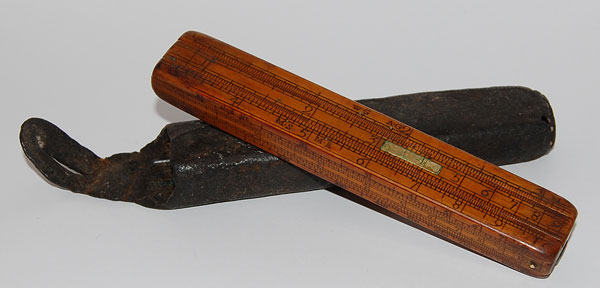 Click photo to enlarge |
|
|
|
This is a pocket-sized Everard style gauging
slide rule, used for the practice of gauging, i.e. computing the
amount of alcoholic liquids in partly-filled casks in order to
figure the excise taxes on them. Taxing people’s pleasures and vices
has always been attractive to governments, and there was much
activity in this space. That’s why Thomas Everard, an officer of the
excise in London, had devised this form of rule in 1683; and why it
remained in widespread use for the next two centuries. The tax
officer would use various calipers and dipping rods to measure the
cask and the depth of liquid in it (thereby figuring the ullage, or
empty portion of the cask) and would then use the various scales on
the slide rule to calculate the volume of ale, wine or spirit. This
is no mean feat, if you consider the complex geometry of a barrel! We know who had made this item, and we also know who its owner was. The former is Edward Roberts of London; which could actually be either of two people of the same name, father and son, who produced slide rules in 1749 – 1784 and 1788 – 1796 respectively. The latter is John Ramsden, Offr [officer] of Excise, who went to the trouble of writing his name on the back of two slides and in one well in the body of the rule (evidently Mr. Ramsden had liked this slide rule as much as I do, and was eager to leave no doubt as to its ownership!) |
|
|
|
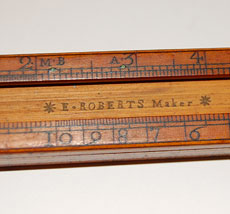
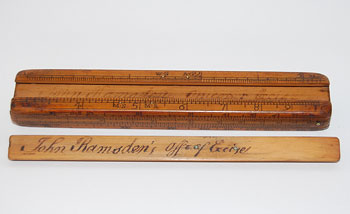 Click a photo to enlarge |
|
|
|
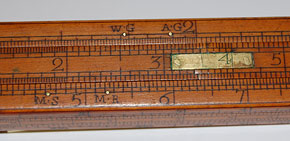
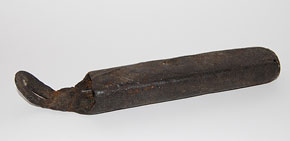 Click a photo to enlarge |
|
|
|
The rule still has its original leather case,
which did a great job preserving its content but had suffered the
ravages of time itself: the leather is hardened and distorted like a
mummified hide. So how was this device used? Let me illustrate with two examples, referring to the scale labels in the scan below (these labels are unrelated to any scale names used in the 18th century). |
|
|
|
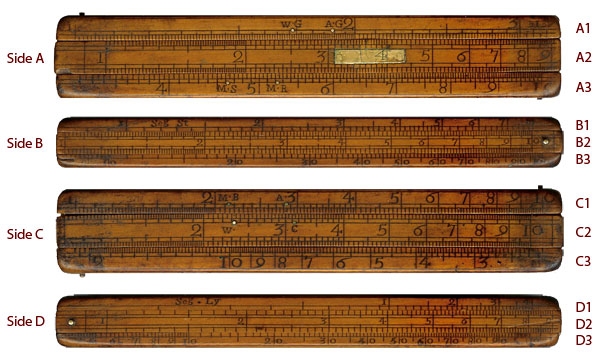 Click photo to enlarge |
|
|
|
Example 1: Ullaging a cask of ale Say you want to calculate the volume, in Ale Gallons, of the ale in a partly full cask of the first variety (casks were classified into varieties by the shape of their curved sides; the common first variety had the geometry of the middle frustum of a spheroid, which is what you’d consider a “barrel shape” today). You measure the cask’s interior diligently and find a 27 inch Bung Diameter (the diameter at the thickest point), 23" Head Diameter (at the flat ends), and 32.5" length. You stand the barrel on its flat end, insert a dipping rod and find the “wet dip” – the depth of the liquid – to be 24". Step 1: Calculate the Equivalent Diameter, which is the diameter of a cylindrical cask of the same volume as this one. This is reckoned by adding a factor to the Head diameter; this factor is derived from the difference between the Bung Diameter and the Head Diameter, and can be computed from tables and formulas or read off a special scale. Our small Roberts rule lacks this scale, but I have it on the side of a more modern excise rule from about 1900 (shown here). This has an inches scale and below it two scales adjusted for the SPHD (Spheroid, or 1st) variety and for the 2nd variety. You look up on the top scale the difference between bung and head diameters of your barrel – 4 inches – and below it you read on the SPHD scale 2.79. You add this to the Head Diameter to get 25.79", the Equivalent Diameter you need. |
|
|
|
Click photo to enlarge |
|
|
|
Step 2: Calculate the volume of the entire cask. You do this using the A1 and A2 scales. You move the slide so the length of the cask – 32.5, on scale A2 – aligns with the gauge point A.G (for Ale Gallon) on scale A1. You now look up the Equivalent diameter – 25.79 – on A1 and read the volume right below it on A2. This comes out as 60.5 Ale Gallons. |
|
|
|
 Click photo to enlarge |
|
|
|
Step 3: Calculate the fractional volume of ale in the cask.
This is called Ullaging. You know that the liquid is 24" deep
out of the cask’s full 32.5"; if it were a cylindrical drum, you
could compute the volume of the liquid from this ratio. However,
this is a barrel, so the relationship of height to volume is
non-linear. You therefore use the ullaging scales on side B (marked
Seg. St, for Segment Standing – that is, a barrel standing
vertically. For a barrel lying on its side you’d use side D, Seg.
Ly, in a similar manner. In both cases, the scales assume a cask of
the first variety). You move the slide so the length of the cask – 32.5, on scale B2 – aligns with the 100% mark at the right end of scale B3. You now look up the depth of the ale – 24 – on B2 and read right below it on B3 the number 75.5. This is the percentage of the full cask that the liquid occupies, by volume: 75.5%. |
|
|
|
 Click photo to enlarge |
|
|
|
Step 4: Calculate the actual volume of the ale. All
that’s left to do is multiply the 60.5 volume of the cask by the
75.5%; you can do this using the plain logarithmic scales C1 and C2,
same as with any slide rule: move the slide so the 10 at the end of
scale C2 aligns with the 60.5 on C1; then look up the 75.5 on C2 and
read the product right above it on C1. You got 45.5, which is the desired volume of ale in Ale Gallons (to the accuracy permitted by this small, ancient rule). Of course, as with all logarithmic slide rules, the decimal point’s location has to be figured in your head. |
|
|
|
 Click photo to enlarge |
|
|
|
Example 2: Gauging a couch of malt This time you want to calculate the volume of malt, the germinating wet grain used to produce beer, which is contained in a rectangular wooden couching frame. You measure the frame and find it to be 83 inches long and 55 wide. You use your dipping rod to measure the depth of the grain in a few places, and figure an average depth of 3.4 inches. The required calculation – multiply the 3 numbers to get the volume in cubic inches, then divide by 2150.42 to convert to Malt Bushels – is done on side C of the slide rule in a single quick step, as follows: you move the slide so the width of the frame – 55, on scale C2 – aligns with the depth, 3.4 on scale C3 (this scale is marked MD, for Malt Depth, at its right end, but the patina of the centuries makes it hard to see the lettering). You now look up the length of the frame – 83 – on scale C1 and read right below it on C2 the result, 7.2 Malt Bushels. The actual exact result (you can do it on a calculator) is 7.21766, close enough – indeed very close, a mere 0.25% error. |
|
|
|
 Click photo to enlarge |
|
|
|
These two examples illustrate the versatility of this little device.
It can do more, including the calculation of squares, square roots,
and reciprocals, and various additional operations related to taxing
alcohol. You can guess some of these operations by considering the
many gauge points – useful constants marked with tiny brass pins –
that are present on the different scales:
With so many “features”, it is small wonder that there were numerous books dedicated to explaining the Everard slide rule and the art of gauging in general; and thanks to Google Books, you can enjoy many of them in scanned form, for example here and here – this last being a 1750 reprint of Thomas Everard’s book. Thanks to Tom Martin for sharing his impressive expertise in this domain. |
|
|
|
Exhibit provenance: eBay, from a seller in the UK. More info: |
|
|
|
|
|
|
|
Home | HOC | Fractals | Miscellany | About | Contact Copyright © 2012 N. Zeldes. All rights reserved. |
|
